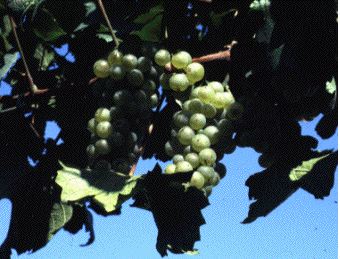
Grapevine looper, Eulythis diversilineata
(Hubner)
The grapevine looper is not currently considered an
important pest of grape, although it has risen to pest status in the
past.
Eggs overwinter on canes in crescent-shaped rows of eight to twelve.
Eggs
hatch in early June in Pennsylvania, although a larva was collected in
April in Virginia. Larvae feed on foliage for six to eight weeks. Food
plants include grape and Virginia creeper. Larvae are of the
measuring-worm
type, with prolegs only on the last two segments of the abdomen. Color
of larvae is highly variable, ranging from yellow-green to red to
nearly
black. Larvae reach a length of about 4 cm. The pupal stage lasts about
ten days and is spent in a loose web spun before pupation on a leaf or
berry cluster. Adults emerge in midsummer and lay overwintering eggs.
Adults
live two or three days. There is one generation annually. A related
species,
the greater grapevine looper, E. gracilineata Guenee, has been
more
commonly collected in North Carolina in some years.
This is taken primarily from an
extension
bulletin by D. G. Pfeiffer & P. B. Schultz, entitled "Major Insect
and Mite Pests of Grape in Virginia" (Va. Coop. Ext. Serv. 444-567
(1986))
Back to Virginia
Vineyard page
Back to Virginia
Fruit Page
